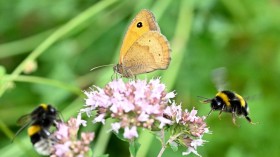The first color snapshot ever taken of Pluto (below) has just come in from NASA's New Horizons spacecraft - a historic milestone for the probe as it continues to move in on the dwarf planet. This unique imagery also offers new insight on distant Pluto and its largest moon, Charon.
The new photo was taken April 9, when the 9-year-old spacecraft was still a stunning 71 million miles (115 million kilometers) away from the tiny world and its moons - roughly the distance between the Sun and Venus.
Up to this point, the probe had been taking voyeur-esque photos with its telescopic Long-Range Reconnaissance Imager (LORRI) - an instrument that magnifies light four times over to see things that normally could not be seen with the naked eye. This allowed experts back at NASA to zero in on Pluto and its largest visible moon, correcting the spacecraft's approach in preparation for its historic fly-by, which will happen July 14.
Now, however, New Horizons has drawn close enough to switch over to its Ralph color imager, allowing for the first color image ever made of the Pluto system by a spacecraft on approach. The image may be a little underwhelming, but NASA notes that it "is a preliminary reconstruction, which will be refined later by the New Horizons science team. [Already] clearly visible are both Pluto and the Texas-sized Charon."
"Scientific literature is filled with papers on the characteristics of Pluto and its moons from ground based and Earth orbiting space observations, but we've never studied Pluto up close and personal," John Grunsfeld, an astronaut and associate administrator of the NASA Science Mission Directorate at the agency's headquarters, added in a statement. "In an unprecedented flyby this July, our knowledge of what the Pluto system is really like will expand exponentially and I have no doubt there will be exciting discoveries."
And even this first color image is revealing things never before considered.
The Mystery Moon
Jim Green, director of NASA's Planetary Science Division, announced during a news conference Tuesday that just by looking at this first snapshot, "you can immediately see a number of differences" between Pluto and Charon.
For instance, the moon, which is about half the size of its host, is far dimmer than Pluto. That could simply be due to a difference in composition between the two worlds, or it could suggest that Charon has a hazy atmosphere never-before-seen. And that is a very real possibility considering the moon's size and how very little we know about these distance worlds in our own solar system.
"There's no doubt, Charon is a rising star in terms of scientific interest, and we can't wait to reveal it in detail in July," said Leslie Young, deputy project scientist at the Southwest Research Institute (SwRI) in Boulder, Colo.
One Shot Wonder
What's interesting about this Pluto mission is that, unlike the Dawn spacecraft, which slipped into the orbits of two other dwarf planets in our solar system (Vesta and now Ceres), New Horizons will have to gather all the scientific data on Pluto it can in one quick fly-by. (Scroll to read on...)
"Our team has worked hard to get to this point, and we know we have just one shot to make this work," said Alice Bowman, the New Horizons mission operations manager at Johns Hopkins University. "We've plotted out each step of the Pluto encounter, practiced it over and over, and we're excited the 'real deal' is finally here."
"This is pure exploration; we're going to turn points of light into a planet and a system of moons before your eyes," added Alan Stern, New Horizons principal investigator.
And after visiting Pluto, the spacecraft will just keep trucking, heading further into the Kuiper Belt to examine a pair of icy and ancient asteroids of interest in that vast region - at least a billion miles beyond the orbit of Neptune, our farthest true planet from the Sun.
"New Horizons is one of the great explorations of our time," added Hal Weaver, a project scientists on the New Horizons team. "There's so much we don't know, not just about Pluto, but other worlds like it. We're not rewriting textbooks with this historic mission - we'll be writing them from scratch."
For more great nature science stories and general news, please visit our sister site, Headlines and Global News (HNGN).
- follow Brian on Twitter @BS_ButNoBS
© 2024 NatureWorldNews.com All rights reserved. Do not reproduce without permission.


![Microplastics Escape Body's Gut to 'Infiltrate' the Brain, Kidneys and Liver [Study]](https://1471793142.rsc.cdn77.org/data/thumbs/full/70195/280/157/50/40/microplastics-escape-bodys-gut-to-infiltrate-the-brain-kidneys-and-liver-study.jpg)

